
Body image issues are pervasive in today’s society. Approximately 91% of women are unhappy with their bodies, while only 5% of women naturally have the supposedly “ideal” body type as portrayed in the media. A negative body image in young adults can lead to many adverse effects, such as anxiety, depression, and eating disorders.
It is especially important to reach out to young adults regarding a healthy body image, as 95% of people with eating disorders are between the ages of 12 and 25. Additionally, it is crucial to keep in mind that body image issues do not only affect women and girls, despite common stereotypes. Research suggests that 10% of people treated for eating disorders are male.
In teenagers and young adults, there are many causes of body image issues. The list below, while certainly not exhaustive, contains some of the most common factors in the development of a negative body image.
- Natural weight gain and body changes due to puberty
- Peer pressure/negative friend group
- Cultural differences and expectations
- Unreasonable body image expectations from media images, celebrities, etc.
- Family members or trusted adults who are overly concerned with their own weight or appearance or their teen’s weight or appearance
- Exposure to material that sexualizes young people
In encouraging positive body image, the most important component is encouraging and open communication regarding changing bodies and outside influences. You can’t completely control the messages that young women are exposed to on a daily basis, but you can help them process and deconstruct these messages in a healthy manner.
Tips for encouraging positive body image in teens and young adults:
- Set a positive body image example: Young women look up to the trusted adults in their lives to model appropriate behavior and expectations. Be mindful of the language that you use regarding your own body and avoid criticizing others’ bodies.
- Communicate about puberty and body changes: Puberty is a confusing time for any teen to navigate, especially when dealing with seemingly random and rapid changes in their mental, emotional, and physical states. As a parent, teacher, or other trusted adult, you can help your teen deal with this difficult experience with open and honest communication regarding what to expect and how to process it, especially reassuring them that they are not alone and that what they are going through is completely normal.
- Encourage positive friendships: Help the young women in your life build an accepting and caring friend group. Teenagers are heavily influenced by their peers, so while you cannot (and should not) choose their friends for them, you can encourage them to gravitate towards people who share their values and goals.
- Foster healthy habits rather than a certain body type: Instead of focusing on a certain ideal weight or body size, encourage your teen to choose healthy foods that make them feel good and are also tasty.
- Discuss media and cultural messages: Encourage your teen to question messages from social media, the Internet, television, etc., especially regarding body pressures.
- Praise achievements: Compliment teenagers on their achievements, efforts, and skills, rather than appearance.
- Promote enjoyable physical activity: Help your teen to find enjoyable physical activities. Make exercise about fun and feeling good rather than achieving a certain body type.
More
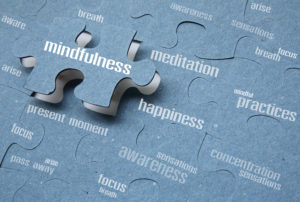 Stress is one of modern life’s biggest obstacles. While the amount of stress varies from person to person, day to day, and month to month, more than two-thirds of people feel stress on a daily basis. Dealing with stress can lead to issues at work, school, and home. Combating stress depends on trying practices, including exercise, diet, mindfulness, and relaxation, to find what combination of stress reduction techniques works for you.
Stress is one of modern life’s biggest obstacles. While the amount of stress varies from person to person, day to day, and month to month, more than two-thirds of people feel stress on a daily basis. Dealing with stress can lead to issues at work, school, and home. Combating stress depends on trying practices, including exercise, diet, mindfulness, and relaxation, to find what combination of stress reduction techniques works for you.
Ways to combat stress:
- Exercise: Yes, get moving! Moderate exercise, such as walking, cycling, vinyasa yoga, swimming, and jogging, are great activities to relieve mental stress. In addition to releasing endorphins that lead to enhanced moods, exercise lowers stress hormones, improves sleep, and leads to more confidence and a better wellbeing. Women should get 150 minutes of moderate exercise each week, which averages to 30 minutes five days a week. Mixing up the activities with yoga one day, swimming the next, and lunch-break walks will help keep it interesting.
- Diet: Certain foods, especially foods high in sugar, lead to the release of stress hormones from the adrenal glands. While the thought of dieting is enough to cause stress, rest assured, small practices can make a big impact on eating. The key is to avoid lofty eating plans and goals, and instead start small and aim for long-term changes. If you typically eat one or two servings of fruit and veggies each day, make a plan to double it. Work on building up to a goal of five servings of fruits and veggies daily. In addition, choose lean protein options (chicken, fish, beans) and avoid fatty foods, processed foods, and red meats. Working to lower sugar and caffeine intake will also help with stress reduction.
- Mindfulness: Learning to be in the moment and accept your current situation is another method to reduce stress. Practicing mindfulness means dedicating time to meditate. An easy way to start is by dedicating five minutes of quiet time to sit and think each day. During this time, listen to your breath, scan your body, find any discomfort (stress often manifests in pain or tension in the neck and shoulders), and let it go. Practicing mindfulness means moving your mind through examining, accepting, and dismissing both mental and physical feelings. For a guided mindfulness practices, look for meditation and/or gentle yoga, all of which can be found in phone apps, online videos, and in-person at local yoga studios.
- Relaxation: In addition to exercise, diet, and mindfulness, which can feel like work, simply look for ways to relax. This is different for everyone, but can include a hot bath, spending time in nature, using aromatherapy candles or oils, reading, getting a massage or pedicure, listening to music, and/or simply taking time to yourself.
More
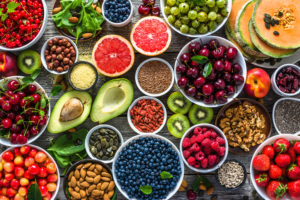
Pregnant women have unique health needs, as the foods they eat are the main source of nutrients for a growing baby. To cultivate healthy eating during pregnancy, it is important for pregnant women to plan in terms of vitamins and minerals and include foods that meet their unique nutritional needs, while limiting or avoiding certain processed foods, meats, and cheeses.
Foods to avoid:
For starters, pregnant women should avoid: refrigerated meat spreads; unpasteurized juices or milk; store-made salads (chicken, egg, tuna); unpasteurized soft cheeses (brie, feta, blue); raw sprouts; raw fish or refrigerated uncooked seafood (sushi, nova-style, lox, kippered, smoked, jerky); processed meats (hot dogs, deli meats); and certain cooked fish (shark, swordfish, king mackerel).
While fish and shellfish provide many important nutrients, such as iron and omega-3 fatty acids, pregnant women should be careful about both the type and frequency of seafood ingestion. The U.S. Department of Health and Human Services Office of Women’s Health recommends the following guidelines:
- Avoid fish high in mercury, such as swordfish, tilefish, king mackerel, and shark
- Eat up to six ounces per week of canned albacore or chunk white tuna
- Eat up to 12 ounces per week of cooked fish and shellfish including shrimp, crab, clams, oysters, scallops, canned light tuna, salmon, pollock, catfish, cod, and tilapia
Healthy foods to eat:
During pregnancy, women need increased levels of folic acid, iron, calcium, vitamin A, vitamin D, and vitamin B12. Specifically, pregnant women need 400 to 800 micrograms (mcg) of folic acid, 27 mg of iron, 1,000 mg of calcium, 770 mcg of vitamin A, 600 international unit (IU) and 2.6 mcg of vitamin B12. While taking supplements may help to reach these nutrient levels, it is preferable to consume vitamins and minerals through foods as certain supplements can contain higher than recommended levels of nutrients, which can be harmful to pregnant women.
To achieve healthy eating during pregnancy, see the list below of suggested foods per nutrient type especially important for pregnant women. This is not an exhaustive list but rather a starting point to help women plan a healthy diet for themselves and their babies.
Folic Acid/Folate
- Whole grains
- Avocados
- Eggs
- Beets
- Asparagus
- Leafy greens
- Legumes (lentils, peas, beans, chickpeas, soybeans, peanuts)
- Citrus fruits
- Brussels sprouts
- Broccoli
- Nuts and seeds
- Bananas
Iron
- Seafood (see specific seafood guidelines for pregnancy above)
- Legumes
- Broccoli
- Dark, leafy greens
- Lean meat
- Quinoa
- Nuts and seeds
- Tofu
- Dark chocolate
Calcium
- Dairy products
- Broccoli
- Dark, leafy greens
- Collard greens
- Soy beans
- Bok choy
- Oranges
- Seafood
- Legumes
Vitamin A
- Sweet potatoes
- Broccoli
- Dark, leafy greens
- Carrots
- Black-eyed peas
- Red bell pepper
- Mango
- Melon
- Apricots
- Tomatoes
- Pumpkin seeds
- Berries
Vitamin D
- Dairy products
- Fish liver oil
- Salmon
- Tuna
*Note: Vitamin D is the hardest nutrient to get solely from foods. A vitamin D supplement is recommended.
Vitamin B12
- Beef
- Chicken
- Seafood
- Dairy products
- Fortified breakfast cereal
- Eggs
More
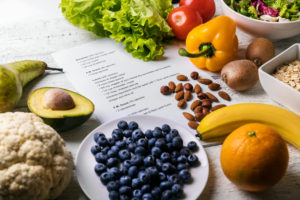 With the endless supply of information available online, it’s not always easy to negotiate healthy eating habits. With the news and social media buzzing about new trends like keto and paleo, it can be hard to keep track. Here’s a quick summary of the current trendy diets, with a suggested plan of how to eat healthy food.
With the endless supply of information available online, it’s not always easy to negotiate healthy eating habits. With the news and social media buzzing about new trends like keto and paleo, it can be hard to keep track. Here’s a quick summary of the current trendy diets, with a suggested plan of how to eat healthy food.
Diet Trends
- The Keto Diet: The keto diet revolves around eating very few carbohydrates and filling up on fatty foods. Essentially, it keeps your body in a state of ketosis; in this state, your body breaks down both dietary and stored body fats. While this diet is certainly not heart healthy, many people use it to jump start the weight loss. However, this updated version of Adkins is not sustainable for the long run because eating diets high in fat is not good for your organs.
- The Paleo Diet: The paleo diet calls for foods that would have been eating by our ancestors in the Paleolithic era (roughly 10,000 to 2.5 million years ago). During this state of evolution, humans were hunters and gathers. Paleo diets include meat, fish, fruits, veggies, nuts and seeds, while avoiding proceeded foods, dairy, legumes, and grains. Similar to the keto diet, paleo diets also limit carbohydrates, however, paleo doesn’t allow dairy or cheese. This diet would likely be hard to continue over a long period due to the extremely limited amount of foods available. Additionally, there is no long-term evidence yet to know if this is safe.
- The Mediterranean Diet: This diet based on the Mediterranean region along the water in Italy, Greece, and France, relying on eating large amounts of lean meat, fruits, and veggies. In fact, fruits and vegetables should make up the largest section of the food pyramid. Olive oil is a key ingredient for cooking and salad dressings. Whole grains, nuts, beans, and legumes are eaten in moderation. Lean meats and fish are favored, as opposed to red meat or processed meats.
Of the three diets discussed, the Mediterranean is the healthiest for long-term use. However, when all is said and done, the best way to lose weight is the old-fashioned way – eat less and move more. Fill up on fruits, veggies, lean protein, and drink plenty of water. And, when possible, avoid or limit processed foods, cheese, sweets, alcohol and other high fat foods.
As for exercise, adults should target 150 minutes per week, breaking down to 30 minutes five days per week. Moderate intensity —such as brisk walking, biking, aerobics, swimming, elliptical use, jogging, and even faster paced yoga— are all good options. The trick is finding what you enjoy and mixing it up to avoid boredom. Consider taking brisk walks at your lunch hour a few days a week, while saving longer work outs for weekends when you have more time.
Sources:
https://health.usnews.com/best-diet/mediterranean-diet/dos-and-donts
https://www.mayoclinic.org/healthy-lifestyle/nutrition-and-healthy-eating/in-depth/paleo-diet/art-20111182
https://health.usnews.com/best-diet/keto-diet
More
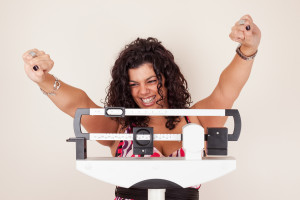 So, you decided that you need to lose some weight? It sounds overwhelming, but it doesn’t have to be. Our society leads us to believe that if we want to lose weight we have to do something drastic, like only eat protein, workout for hours a day, do a juice cleanse, go on a fad diet, or reduce our calorie intake to 1200 calories per day. Most of these drastic attempts to lose weight result in a way of life that is near impossible to sustain. And most of them are unhealthy.
So, you decided that you need to lose some weight? It sounds overwhelming, but it doesn’t have to be. Our society leads us to believe that if we want to lose weight we have to do something drastic, like only eat protein, workout for hours a day, do a juice cleanse, go on a fad diet, or reduce our calorie intake to 1200 calories per day. Most of these drastic attempts to lose weight result in a way of life that is near impossible to sustain. And most of them are unhealthy.
Slow and Steady Wins the Race
Sure you might try a fad diet and drop 20 pounds in a month. Great right? Not really, if you don’t change your lifestyle and get rid of unhealthy habits, chances are you will gain all of that weight back plus some more in the months to come.
So what works? Lower amounts of weight loss (1-2 pounds a week) over a long amount of time is the best method. The way you can achieve long term results is by focusing on making changes that you can sustain over the long term.
How? Start with this list of easy tweaks you can make to help you lose the weight and keep it off for good!
10 Small Steps to Weight Loss
- Eat your veggies. Yes, your mom told you to eat your broccoli and she was right! Veggies have very low calories (almost none) and fill you with many different nutrients and satisfying fiber. If plain veggies sound blah to you, dip them in hummus or non-sweetened Greek yogurt (which you can add flavor to by mixing in herbs and spices).
- Fuel up with fruit. Craving ice cream or candy? Fruit is nature’s candy. When you are craving something sweet, grab and apple or munch on some frozen grapes or berries. If you must have some chocolate, melt some dark chocolate and dip in a few strawberries. Your calorie consumption will be much less and you won’t feel like you’re missing out.
- Cook at home. When you cook your own meals, you save on calories, avoid huge portion sizes and you know exactly what is going into your food. Planning your meals and grocery shopping ahead of time will help you stick to your plan during those hectic weekdays. In addition, if you are going to work, pack your lunch instead of eating out.
- Make smarter food swaps. Taco Tuesday? Swap out fat laden beef with lean ground chicken or turkey. Ditch your burrito shell and make a taco salad with a few tortilla chips crumbled over the top to get a satisfying crunch. Swap regular white bread for whole grain bread. Eat an English muffin instead of a bagel. For almost any food, there is a healthy alternative. You get the idea!
- Move every single day. Obviously, exercise is an important part of any weight loss journey. You don’t have to log long hours at the gym. If you’re first starting out, you might want to begin by walking. Strive for 10,000 steps a day. Get a pedometer or use your smart phone to log your steps. Get a buddy to meet you at the gym so that you’ll be held accountable. Join a class or take up swimming. Dance in your living room! Whatever you like to do, make it a point to move every day.
- Limit your alcohol consumption. Not only do alcoholic drinks have massive amounts of empty calories, drinking also impairs your judgement and may lead you to make poor food choices or overeat.
- Be cognizant about your portion sizes. Measure your portions or use a smaller plate at dinner time.
- Ditch the soda. A can of soda can have upwards of 150 calories. A few glasses of soda per day and you’ll be packing on the pounds. Even diet soda has been linked to obesity. Instead, fill your glass with water or sparkling water to get those bubbles you crave.
- Drink more water. Drink water throughout the day and a full glass a half hour before you eat. You’ll feel fuller earlier and water keeps everything moving and in working order.
- Keep a food journal. Just the act of writing down what you are eating daily will help you become accountable to what you are feeding your body. It will also help you to identify how to make better choices. Free apps such as MyFittnessPal or paid apps like Weight Watchers can help you track your food and activity.
You don’t have to do everything on this list at once!
There are a lot of reasons why you might need to lose weight. Whether you’re trying to fit into your skinny jeans again, lower your cholesterol, decrease your risk of Type II diabetes or improve your overall energy level. Pick one or two items on this list and work on them for a few weeks. Once you’ve mastered that goal, add in another lifestyle change.
Share your results with our community by posting a response below. Or share other ideas on how to achieve long term results!
More
 Do you know your ABCs? No, not those—the ABCs of a healthy diet. We’re talking about the vitamins, minerals, and nutrients that women need for optimal health. Even if you think you know which letters of the alphabet make essential vitamins (C? D? A?) ask yourself the more important question: Are you getting enough of each one? Despite our best efforts to eat healthily, many women are deficient in at least one essential nutrient. To make sure you are staying healthy, especially through winter cold and flu season, study up on the A, B-12, Cs of vitamins that you need in your diet.
Do you know your ABCs? No, not those—the ABCs of a healthy diet. We’re talking about the vitamins, minerals, and nutrients that women need for optimal health. Even if you think you know which letters of the alphabet make essential vitamins (C? D? A?) ask yourself the more important question: Are you getting enough of each one? Despite our best efforts to eat healthily, many women are deficient in at least one essential nutrient. To make sure you are staying healthy, especially through winter cold and flu season, study up on the A, B-12, Cs of vitamins that you need in your diet.
Vitamin A
According to the World Health Organization (WHO) vitamin A deficiency (VAD) is the leading cause of preventable blindness in children. In the most severe cases, it may also lead to night blindness in pregnant women, and increase the risk of maternal mortality. Symptoms of vitamin A deficiency may include dry eyes and skin, and an inability to see in dim light. Protect yourself, especially if you are pregnant or hoping to become pregnant, by ensuring your diet includes such vitamin A-rich foods as carrots, sweet potatoes, kale, spinach, broccoli, and eggs.
B-12
Many women don’t get enough of vitamin B-12, a vitamin essential for promoting neurological function, making red blood cells, and improving healthy digestion. Basically, vitamin B-12 is a big deal. Especially if you are a vegetarian, or eating a gluten-free diet, you may not be getting enough B-12. Women who are pregnant should also talk to their OBGYN about increasing their B-12 intake. Side effects of B-12 deficiency may include fatigue, anemia, tingling in the extremities, confusion, and a swollen tongue. To ensure you’re getting enough B-12, increase your intake of eggs, milk products, cheese, meat, fish, shellfish, and poultry.
Calcium
Women need calcium to promote healthy bones and minimize their chances of developing osteoporosis as they age. Unfortunately, even those who love their ice cream are often Calcium deficient. Symptoms may include muscle cramps or muscle weakness, fatigue, irritability, and a tingling sensation in the limbs. You can find ways to add calcium to your diet without adding more dairy, which is good news for women who are lactose intolerant. Other calcium-rich foods include almonds, broccoli, figs, oranges, sardines, navy beans, kale, and tofu.
Vitamin D
You know vitamin D as the sunshine vitamin, but what you may not know is that many women don’t get enough of it—especially those who are sun-conscious and those who live in a cloudy climate. Vitamin D is essential for protecting the immune system and fortifying our bones. If you’re pregnant, your OBGYN will likely want you to increase your Vitamin D intake as well. If you’re vitamin D deficient, you may experience fatigue, fragile bones, depression, or be at higher risk for obesity, and type II diabetes. Vitamin D doesn’t occur naturally in many foods, so to make sure you’re getting enough. Try to spend 15 to 30 minutes a day in the sun (and remember to apply sunscreen in all seasons). You may also be able to boost your vitamin D by eating foods fortified with extra vitamin D, such as breakfast cereals, as well as milk, egg yolks, cheese, yogurt, and salmon.
Folic Acid
Folic acid is responsible for helping to produce red blood cells and is essential for proper DNA production, which makes it another necessary vitamin for pregnant women, and especially for women looking to conceive. Symptoms of a folic acid deficiency may include fatigue, mouth sores, and gray hair. It may also cause anemia, a condition with such symptoms as weakness, irritability, shortness of breath, and pale skin. Foods rich in folic acid include spinach and other leafy greens, citrus fruits, beans, and rice.
Iodine
Iodine is a nutrient that is responsible for helping to regulate the thyroid hormones that control the metabolism. Iodine deficiency is particularly dangerous for women who are pregnant and their fetus, which is why many prenatal vitamins include iodine. Women who are suffering from an iodine deficiency may experience a swelling of the thyroid around the throat (known as goiter), weight gain, fatigue, thinning hair, and constantly feeling cold. Fortify your diet with iodine-rich foods, such as sea vegetables like kelp, cranberries, yogurt, navy beans, strawberries, and cheese.
Iron
That’s right; Popeye isn’t the only one who needs spinach. You do too, Olive Oil. Since women menstruate monthly, they are at a higher risk of being iron deficient. Even pregnant women are susceptible to iron deficiency, which could cause fatigue, shortness of breath, dizziness, and brittle nails. Make sure you’re getting enough iron-rich foods, such as spinach, lentils, pumpkin seeds, raisins, quinoa, and…dark chocolate. You’re welcome.
If you are pregnant or hoping to become pregnant, and have any questions or concerns about your diet or vitamin intake, talk to your OBGYN. Your doctor can help you put a plan in place to make sure you maintain healthy levels of all your vitamin A, B, Cs.
More
How to Survive the Holidays Without Overindulging
 It’s the most wonderful time of the year again, and you’re freaking out. Everywhere you go, you don’t see glistening snow and smell effervescent pine cones. You see sugar topped cookies and cakes and smell savory roasted meats. You love so much about the holiday season, but you dread all the extra calories that come along with parties, gifts of food, and magical memory merrymaking.
It’s the most wonderful time of the year again, and you’re freaking out. Everywhere you go, you don’t see glistening snow and smell effervescent pine cones. You see sugar topped cookies and cakes and smell savory roasted meats. You love so much about the holiday season, but you dread all the extra calories that come along with parties, gifts of food, and magical memory merrymaking.
Don’t hide in your house all season long just to avoid the temptation of holiday eats. Follow these seven holiday hacks to get the most out of the season of joy without overindulging or packing on the pounds.
- Protect Yourself from Mid-Day Temptation with a High Protein Breakfast. Oh no. Carol brought her famous gingerbread cookies into the office, and you’re starving. Before you know it, one little gingerbread man has turned into four, and you’re laden with guilt and gumdrop button crumbs. You’ll be better able to fight mid-day sugar cravings and unexpected temptations if you start with a healthy breakfast that includes hunger-quenching protein. Consider a healthy protein shake as a way to start your day off right.
- Eat Something Healthy Before Grocery Shopping. Not only are you surrounded by holiday treats at home, the office, and all your friends’ houses, you’re surrounded at the grocery store. Walk through the bakery this time of year and it’s even more tempting than usual since it’s packed with holiday cookies, fruit cake, and yule logs. Researchers from Cornell University found that if you eat something healthy before you grocery shop, you’ll be less likely to add unnecessary junk food items to your cart. Never grocery shop hungry, or else your bad decisions will follow you home for the holidays in the form of pumpkin spice ice cream, pumpkin spice bagels, and pumpkin spice potato chips (oh yes, they’re real).
- Don’t Skip Your Daily Workout. Your calendar may be filled with parties, shopping, and other holiday commitments, but it’s more important than ever to make sure you’re getting exercise daily. Thirty minutes of exercise five days a week will help you stay energized, burn calories, and make better dietary decisions. And yes, mall walking can count.
- Don’t Skip Meals Before Holiday Parties. Admit it. You skipped lunch before your Thanksgiving dinner, didn’t you? Let us guess. You figured you’d eat the equivalent of two of your regular meals during your Thanksgiving feast, so you would be better off skipping lunch. This choice can be an all-too-easy diet mistake. You’re better off eating a small, healthy meal before that big dinner party. Walk into cocktail hour starving, and you’ll be more likely to indulge in extra hors-d’oeuvres and chug an extra pint. Take the edge off your cravings with a healthy lunch so you can enjoy the company of the other party guests, and make sensible choices, no matter what’s on the menu.
- Take Your Dog for an Extra Walk (or Two). It can be tempting to stay indoors when the weather turns cold, but you and your dog both need to get your 10,000 steps in for the day. Commit to walking your dog before, or after dinner every day. Or, step up the challenge and walk him before and after dinner. We’re sure he’ll thank you with lots of extra love.
- Put Away Your Loose-Fitting Sweats. On chilly weekend days, all you want is to cozy up in warm sweatpants, but doing so may thwart your diet plan. When you regularly wear loose-fitting clothes, it can be easier not to notice the addition of a few extra pounds. Instead, choose formfitting clothing that makes you feel confident. It will encourage you to exercise and make healthy meal decisions throughout the day when you’re not hiding under layers of cotton-polyester blend.
- Stop Drinking Soda. Just Stop. Empty calories that come from sugary drinks can quickly lead to extra pounds you never saw coming. Always choose water over pop, sweet teas, energy drinks, and that extra glass of wine, especially during the holidays. Not only will you cut back on calories, drinking plenty of water will help you stay hydrated, shed pounds, curb cravings, and make healthy decisions throughout the day.
Remember, you don’t have to fear the holidays or go into December feeling resigned to weight gain. Yes, you will face extra food temptations, and your calendar will make it harder to find time for exercise this season, but consider it a challenge to head into 2018 as the best version of you possible—healthy, happy, and confident.
More
The Reasons Why Women Should Strive for 10,000 Steps Per Day
 It seems that everywhere you go these days, you hear increasingly more men and women talking about the total number of steps they’ve taken that day. They’re checking their fancy wrist gadgets—pedometers, fitness trackers, smart watches—as they strike to reach what must be a magic number: 10,000 steps. Is it hype? Is it healthy? How does your body benefit from 10,000 steps? Why not 10,001 or 9,999? What makes 10,000 steps the Goldilocks of fitness goals? The truth is there is some science behind the 10,000-step goal, making it more truth than hearsay. Learn what 10k every day can do for you, and why it’s time you started counting your daily steps too.
It seems that everywhere you go these days, you hear increasingly more men and women talking about the total number of steps they’ve taken that day. They’re checking their fancy wrist gadgets—pedometers, fitness trackers, smart watches—as they strike to reach what must be a magic number: 10,000 steps. Is it hype? Is it healthy? How does your body benefit from 10,000 steps? Why not 10,001 or 9,999? What makes 10,000 steps the Goldilocks of fitness goals? The truth is there is some science behind the 10,000-step goal, making it more truth than hearsay. Learn what 10k every day can do for you, and why it’s time you started counting your daily steps too.
Why 10,000 Steps?
Studies show that increasing one’s walking habit to 10,000 daily steps results in important health benefits. It’s important to keep in mind that while 10,000 is the goal most researchers suggest for the average American, if you are not active today, any increased amount of walking, stepping, or jogging will benefit your health. Still, 10,000 steps is an obtainable goal for the average adult and it’s a number that has an intrinsically motivational power over us.
Benefits of 10,000 Steps
Adults who reach 10,000 steps per day have been known to benefit from:
If 10,000 steps seems far too unobtainable based on your work or family responsibilities, know that the Centers for Disease Control and Prevention (CDC) recommend that adults engage in 150 minutes of moderate activity each week, which may include brisk walking. The CDC’s 150 minutes translates to about 7,000 to 8,000 steps, which may feel more reasonable to some and still meets recommended health goals.
How to Reach the 10,000-Step Milestone
If you’re ready to take the 10,000-step challenge, but aren’t sure how to achieve such a lofty goal, know that the 10,000-step achievement can be reached more easily than you may think. The average adult already walks about 6,000 steps per day through normal activity. To strive for 10,000, simply begin adding extra walking sessions to your normal routine. Start by adding an extra 30 minutes of brisk walking into your day. That alone will start you off with around 8,000 steps. You can achieve your 30 minutes before work by walking your dog, by taking your kids for a walk around your neighborhood, or even getting off the subway one stop early and walking the rest of the way to your office.
Invest in a Tracker
If you’re set to take on the 10,000-step challenge, you’ll want to invest in a pedometer or fitness tracker. You don’t need the most expensive model on the market, but you will need a tool to help you keep track of your daily step progress. (Many smart phones have apps that will also track steps.)
Remember, even if after a few weeks, you find you’re struggling to reach 10,000 steps, the most important thing is that you are getting up and being active. Any improvement in your activity level is an improvement for your health and wellbeing. If you have any questions regarding the amount of exercise you should be receiving, talk to your doctor.
More

Most women would say that they were happy to leave their teenage years behind them, especially the friendship dramas, the pre-cell phone lifestyle, the bad hairstyle choices (remember temporary perms?), and especially the teenage acne. Some women, however, don’t get to leave the stress and anxiety of a bad complexion in their high school lockers. Data shows that 35 percent of women in their thirties, 26 percent of women in their forties, and 15 percent of women age 50 and older are still battling the acne breakouts often thought of as only plaguing teens and tweens. If you are among those women living under layers of concealer to hide adult acne, know that there are ways to clear your complexion that don’t involve photo filters.
What Causes Adult Acne?
Hormonal Changes
Think hormones only happen when you’re 16? Think again. Anytime your body increases its production of testosterone, it also increases its production of the oils that clog pores and lead to pimples. According to one study, women over age 33 are more likely to experience premenstrual pimples than younger women. The hormonal changes experienced during menopause can also result in an increase in acne.
Stress
As if it’s not already difficult enough to manage stress in your life, high levels of cortisol that are triggered by periods of stress can trigger acne in return. You know what that means. Stress + acne = Stress = more acne. A frustrating cycle.
A High Sugar Diet
A diet high in sugar can complicate a myriad of health issues, and acne is one of them. A high level of simple carbs and sugars, such as pastas, breads, and sugary desserts, can provoke a breakout in already problematic skin.
Dairy Products
Some studies have also shown a link between adult acne and dairy products. It’s believed that dairy-triggered acne break-outs are caused by the hormones present in some products.
Reduce Sodium Intake
Sodium is another food thought to trigger acne outbreaks. Some doctors believe the iodine frequently found in table salt may exacerbate acne breakouts.
Polycystic Ovarian Syndrome (PCOS)
PCOS is a hormonal disorder that impacts five to 10 percent of women. It causes enlarged ovaries with small cysts on the outer edges. If your adult acne is accompanied by other, more severe side effects of imbalanced hormones, such as excessive hair growth or irregular periods, talk to your OBGYN.
Treating Adult Acne
The best way to treat your adult acne will depend on its underlying cause, however what follows is a list of trusted acne-prevention tips:
- Decrease your overall consumption of refined carbohydrates and sugars. Too much sugar can spike the hormone levels that trigger outbreaks.
- Reduce overall dairy consumption. Some believe that fat free milk in particular, which has more sugar that higher fat versions, may be more likely to trigger an outbreak than other types of dairy products.
- Choose low-sodium food products. Keep your overall sodium consumption below 1,500 mg per day by choosing low-sodium varieties of prepackaged foods.
- Talk to your OBGYN about birth control pills. Depending on your family plan, birth control pills may be an effective way to help normalize the hormonal surges associated with your monthly cycle that can wreak havoc on your oil glands
- Consider blue light therapy. Blue light therapy is a treatment that uses light rays to penetrate follicles and kill acne-causing bacteria. If your acne is severe, your doctor may recommend photodynamic therapy, which adds a topic solution to a traditional blue light therapy treatment.
- Choose tea tree oil over benzoyl peroxide to treat pimples. Benzoyl peroxide can be drying, especially on adult skin. Tea tree oil has natural antiseptic properties to help treat mild to moderate acne outbreaks.
- Manage your stress. Exercise regularly, make sure you’re getting enough sleep each night, and balance your commitments and priorities to make sure you don’t fall victim to the skim complications that stress can cause.
- Choose topical skin care products that include antibacterials and retinoids. Retinoids are particularly important for adult women, since retinoids stimulate collagen production, which helps to fight acne. If OTC products aren’t doing enough to clear your complexion, talk to your dermatologist.
With a healthy diet, a strategy for managing stress, and a commitment to a face cleansing routine, you don’t have to feel like you are back in high school. Instead, you can keep your face pimple-free, smooth, and radiant. Now let’s talk about those high school prom dresses you’ve been thinking you may want to wear again.
More
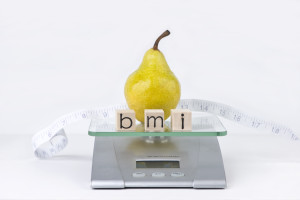 If you care about your personal fitness, then you probably closely monitor certain data factors. You document your PRs, you track distance on your GPS, and you measure your bike speed in MPHs. You also likely monitor your BMI, or body mass index, especially if you are monitoring your weight as part of your fitness plan. While tracking and measuring various fitness measurements can help you accomplish your goals, before you start to monitor your fitness progress using BMI as your sole benchmark, understand what BMI really means, and why it may not be a fair indicator of fitness.
If you care about your personal fitness, then you probably closely monitor certain data factors. You document your PRs, you track distance on your GPS, and you measure your bike speed in MPHs. You also likely monitor your BMI, or body mass index, especially if you are monitoring your weight as part of your fitness plan. While tracking and measuring various fitness measurements can help you accomplish your goals, before you start to monitor your fitness progress using BMI as your sole benchmark, understand what BMI really means, and why it may not be a fair indicator of fitness.
What is BMI?
BMI, or body mass index, is a simple mathematical formula that uses a person’s height and weight to determine his obesity. To calculate your BMI, divide your weight in pounds by your height in inches squared, then multiply the results by 703. The resulting BMI numbers are grouped into categories to determine whether your weight is normal, or if you are under or overweight:
- Underweight = <18.5
- Normal weight = 18.5 – 24.9
- Overweight = 25 – 29.9
- Obese = BMI of 30 or greater
BMI as a National Benchmark
BMI became a nationally-recognized standard measurement in June 1998 when the National Institutes of Health announced that BMI was to become their obesity measurement standard. The issue that many have identified with relying on a single BMI number as an indication of obesity is that the BMI calculation methodology skews a limited set of data factors and could falsely indicate that a fit, healthy person with little fat is overweight, when in reality, they are healthy and fit.
BMI as a Faulty Measure of Fitness
While BMI takes into consideration height and weight in calculating potential obesity, it is not a diagnostic tool. BMI fails to take into consideration several key factors of fitness, such as age, gender, waist size, and proper proportions of bone to muscle to fat. For example, since bone is denser than muscle, and twice as dense as fat, BMI does not properly account for those who have strong bones, dense muscle tone, and low levels of fat. Such individuals could calculate for themselves a BMI in the overweight range when truly, they are not at a high risk of the conditions complicated by obesity.
A Fair Measure of Fitness
If you are looking for a more accurate fitness calculation, many experts agree that waist circumference is a better indication of obesity than BMI. A waist circumference that is greater than 40 inches for men and 35 inches for women has been linked to a higher risk of type 2 diabetes, high blood pressure, abnormal cholesterol levels, and heart disease when BMI is 25 to 34.9.
Of course, if you are looking for the most reliable source of weight advice, you can always rely on guidance from your physician. To truly calculate your obesity risk, or to determine your level of “fitness,” a health care professional will assess a variety of factors, such as body fat percentage, diet, exercise patterns, and family history.
More










